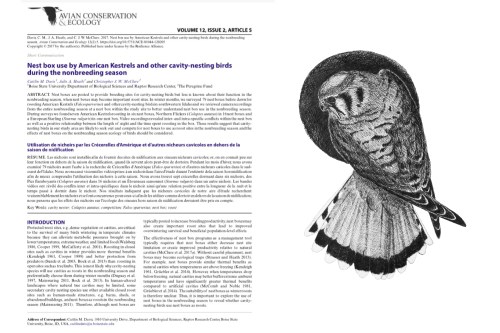Published in the Journal of Raptor Research: Dietary Plasticity in a Specialist Predator, the Gyrfalcon (Falco rusticolus): New Insights into Diet During Brood Rearing
by Bryce W. Robinson
I’m privileged to once again see a painting of mine don the cover of the Raptor Research Foundation’s quarterly publication, the Journal of Raptor Research. This time, however, is more special since the painting of a Gyrfalcon carrying its prey, an Arctic ground squirrel, corresponds to the feature article authored by myself and Travis Booms, Marc Bechard, and David L. Anderson.
Our publication titled “Dietary Plasticity in a Specialist Predator, the Gyrfalcon (Falco rusticolus): New Insights into Diet During Brood Rearing” details patterns we documented through implementation of nest cameras in 20 Gyrfalcon nests in 2014 and 2015. The largest camera study of nesting Gyrfalcons provided us with many new insights into the biology of this species, some of which we have already published, some that we have not. In this publication, we document a previously undescribed shift in prey use throughout the nestling period, from a diet of mostly Ptarmigan early in the season, to squirrel in the late season. This shift to squirrel is an important consideration on many levels. It highlights the nuances to Gyrfalcon prey use in Alaska, and the potential importance of squirrels in the later season for juvenile success and development. The apparent importance of squirrels also has implications for understanding ecosystem changes and how shifts in prey landscapes may impact Gyrfalcon reproduction. The stage is set to explore further.
Below are a few photos that describe the work that went into producing this publication. These highlight a some of the >750,000 nest camera images we collected from which the diet was quantified, as well as photos of the field work, and the people that made this effort possible.
You can read our paper in the Journal of Raptor Research here:

A female Gyrfalcon feeds nestlings. Image copyright Bryce W. Robinson/The Peregrine Fund.

A female Gyrfalcon feeds her newly hatched nestling, alongside hatching eggs. Image copyright Bryce W. Robinson/The Peregrine Fund.

Female Gyrfalcon delivers an Arctic ground squirrel to nestlings. Image copyright Bryce W. Robinson/The Peregrine Fund.

A female Gyrfalcon stands alongside c. 14 day old nestlings. Image copyright Bryce W. Robinson/ The Peregrine Fund.

Parental care photo 1. A female (left) broods newly hatched young, reluctant to leave the nest at the male’s (right) arrival. Every Gyrfalcon would occasionally look at the camera, as seen here, but were otherwise unaffected by its presence. Image copyright Bryce W. Robinson/The Peregrine Fund.

Parental care photo 2. In some cases, males were keen to participate in brooding and feeding young, as is shown here. In even fewer cases, the females were tolerant of this behavior. Image copyright Bryce W. Robinson/The Peregrine Fund.

Bryce W. Robinson sights in a nest camera at a Gyrfalcon nest. Image by Caitlin M. Davis.

Bryce W. Robinson rappelling into a Gyrfalcon nest in western Alaska. Image by Neil Paprocki.
Special thanks to the following people that made the field work happen

John Earthman and Tinsel

Neil Paprocki

Ellen Whittle holding a Gyrfalcon nestling in 2015.

Mark Jeter and Ellen Whittle against an Alaskan landscape in 2015.
Special thanks to the institutions that made this work possible: Boise State University, Alaska Department of Fish and Game, and The Peregrine Fund









